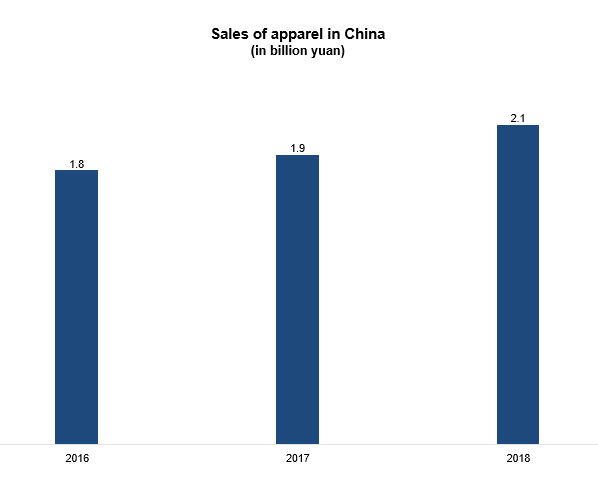Sensory marketing research is the study of customers’ perception of product through touch, smell, hearing, taste and sight. When shopping for clothes, Chinese consumers are increasingly looking for a pleasant sensation and comfort. To meet these demands, companies are requesting clothing sensory research in China to evaluate their products. Mechanical, thermal and surface tests are necessary, but not sufficient to assess the customers’ comfort.

Why clothing sensory research in China is important?
It is important to create the atmosphere in the shop, where customer will be in a good mood and will be satisfied. Shopping center managers and store owners are increasingly focusing on sensory marketing. While there isn’t much research yet on how music, color, or aromatic effects drive sales, a comfortable shopping space clearly contributes to customer loyalty. The main thing for companies who decide to try sensory marketing is to find exactly what the majority of customers like.
Sound marketing in clothing industry
Each clothing store has its own characteristics, which largely determine the choice of musical accompaniment. To understand what kind of music is right for your store, you need to answer questions about the products you offer, about how the number of customers changes during the day. For example, in the morning there are a lot of retirees, in the afternoon housewives, and in the evening business people.
To conduct auditory sensory research in China Daxens begins the selection of musical themes, based on the advice of professional marketers. For example, the owner of a youth clothing store must choose dynamic and rhythmic music.
Clothing styles often match people’s musical tastes. Therefore, the musical design must correspond to it. Young people often “listen and wear” the same thing. Music influences the emotions, cognitions and behavior of shoppers in a store in different ways. The type of music, genre, and tempo determine the amount of time a person spends in a store and the speed at which they move through products.

How to choose music for the clothing store
Fashion boutiques go well with music that enhances the trendy atmosphere. Fashionable music playing on the catwalks would be the perfect setting for a store like this. Bridal salons and ball gown shops go well with solemn music, which sets customers up for the future holiday.
The main task when installing sound equipment is to make sure that the sound source cannot be localized. A localized sound source, such as a single speaker, will begin to grab the visitor’s attention, even if unconsciously. However, the music should not interfere with this. For the same reason, there should be a certain sound level: not loud and not quiet. A barely audible sound will make the visitor listen, strain, while too loud will distract attention from the purchase.

To achieve an even distribution of sound that obscures the source of the music, the correct use of acoustic devices is essential. Ceiling acoustics are best suited for this. Apart from the fact that such speakers are cheaper, they allow you to create the most even distribution of sound. When the speakers are on a wall, the sound will decrease as you move towards the center, and then increase again as you move closer to the speaker installed on the opposite side. When the required number of speakers is on the ceiling, the sound level does not change wherever the visitor moves. And music does not distract him from shopping.
Touch sensory marketing in China
Another important human sense is touch. It occurs through the receptors of the skin, with which it determines the shape of objects, their size, consistency, temperature, dryness or humidity, position and movement in space. Physical contact is an essential part of a buying decision. When buying clothes, you need to feel the texture. Therefore, it is crucial to pay attention to how customers will perceive it through touching.
Visual sensory marketing in clothes industry
To access the visual part of clothes the eye-tracking research in China can be helpful. Visual sensory research is about color, lighting, and store layout. They have a huge impact on mood and purchasing behavior. The store must stand out from the environment and appear visually stimulating in order to grab attention and interest people who can enter and explore. The layout of the store should allow customers to move freely and have easy access to goods. Lighting is also a vital element. For example, jeans or men’s suit store should have cooler tones and lights to create a comfortable atmosphere. Additional lights on some products generate more interest than others.
Process of clothing sensory research in China
Clothing sensory evaluation in China includes several steps:
Step 1: Desk research
First of all, the Daxens team does comprehensive research on the clothing market in China. This includes market segments, key players, and the role of e-commerce. Also, Daxens evaluates trends and risks and strategies that can be successful in this market.
Step 2: Competitor assessment
Daxens will do an in-depth analysis of your competitors’ strategies, strengths and weaknesses.
Stage 3: Selection of focus group participants
As a next step, Daxens uses experts to find focus group participants in China. Also, our team provides experienced moderators to conduct focus group research.
Step 4: Clothing sensory research in China
Sensory research incorporates principles of experimental design and statistical analysis to the human senses. This is a wide range of different methodologies.
Our team has specialized equipment and software to carry out clothing sensory evaluation in China. For example, Daxens might do in-store research, testing the overall environmental impact by playing with different senses, such as different lighting and sound options.
In addition, our team organizes small focus groups and moderates group sessions according to the needs of the client’s project.
Step 5: Quality control and analysis
Daxens will check the data obtained using software and scientific formulas to calculate the error rate. This will help to get reliable results. In addition, our team used multivariate statistical methods to analyze various data and characteristics. It also makes it easier to interpret the results of clothing sensory research in China.
Step 6: Final Report and Recommendations
After evaluating the collected data, clothing sensory research in China, Daxens creates sensory maps for better visualization and transmission of results. Our team also provides advice on how to tailor products to attract customers. For example, what changes in the sensory environment are preferred for Chinese consumers.
What Daxens will provide for your clothing sensory research in China
Daxens takes care of every aspect of clothing sensory evaluation in China. This includes participants, devices, data collection and visualization as well as suggestions for improvement. To learn more about the methodology, contact our Daxens consultants in China.
